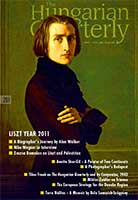Amrita Sher-Gil: A Painter of Two Continents
Amrita Sher-Gil: A Painter of Two Continents
Author(s): Géza BethlenfalvySubject(s): Fine Arts / Performing Arts
Published by: Society of the Hungarian Quarterly
Summary/Abstract: On December 5, 1941 a beautiful woman passed away twenty-eight years young. She died, but her spirit, bound up in her art, is “deathless”. Aptly A-MRITA means immortal in Sanskrit (A - denotes “-less”, -mrita “death”). Amrita Sher-Gil was one of the most celebrated artists of pre-independence India and among the founders of Indian modern art, uniting European and Hungarian traditions with ancient Indian art. Despite her youth, she left behind an oeuvre of almost two hundred scintillating paintings. Yet she found it hard to sell them. Securing her independence was a perennial challenge. Times change. In the first days of March 2006, the Delhi-based industrialist Nand Khemka successfully bid 69,000,000 rupees (USD 1.5m) for Village Scene at the Delhi auction house Osian’s. Sher-Gil’s works rarely appear on the market, so it is understandable that this undoubted masterpiece fetched such a vaulting price. Following a period of neglect, Amrita Sher-Gil now takes her place among the nine masters whose works, according to the Archaeological Survey, are art treasures of India and cannot be taken out of the country. Amrita Sher-Gil was born in Budapest on January 30, 1913 into a family of art-lovers. Her mother, Marie Antoinette Gottesmann, was Hungarian, and her father, Umrao Singh Sher-Gil of Majithia, a Sikh aristocrat. Marie Antoinette (Mária Antónia) Gottesmann of Erdôbakta learned to play the piano as a child and wanted to become an opera singer. For this purpose she was packed off to Rome, where she also became fluent in Italian. Music and art were family traditions in their affluent bourgeois home. Her mother, Antonia Levys-Mártonfalvy, was also well known for her brilliant singing and piano playing. Amrita’s mother was an adventure-seeker. When she was around twentynine she visited London to continue her musical studies and became acquainted with Princess Bamba Sofia Jindan. This meeting changed her life. Princess Bamba was the granddaughter of Maharaja Ranjit Singh (1780–1839), the Sikh ruler of Punjab for nearly forty years, the last stronghold of resistance against the British occupation in the whole of India. Many foreign soldiers were employed in his court, and a Hungarian painter, August Schoefft, whose paintings depict the grandeur of this great epoch of Indian history (it was Shoefft who made the only lithograph portrait of Alexander Csoma de Kôrös). Some time after the British finally defeated the Sikhs Ranjit Singh’s youngest son, Duleep Singh, was taken to England, where Princess Bamba was born much later.
Journal: The Hungarian Quarterly
- Issue Year: 2011
- Issue No: 201
- Page Range: 87-98
- Page Count: 12
- Language: English

